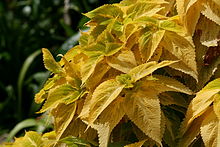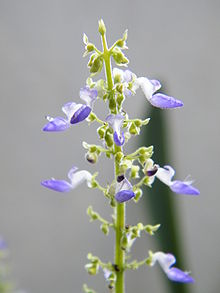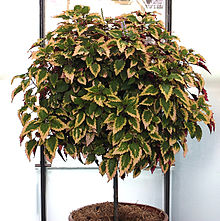- Coleus
-
Coleus 
Hybrid Coleus leaves Scientific classification Kingdom: Plantae (unranked): Angiosperms (unranked): Eudicots (unranked): Asterids Order: Lamiales Family: Lamiaceae Genus: Solenostemon Species See text.
Solenostemon is a genus of perennial plants, native to tropical Africa, Asia, Australia, the East Indies, the Malay Archipelago, and the Philippines. They are commonly known as Coleus, a name which derives from an earlier classification under the genus name Coleus, which is currently treated as two: with species included in either the genus Solenostemon or in another genus, Plectranthus.
Contents
Species
Species include:
- Solenostemon autranii (Briq.) J. K. Morton
- Solenostemon rotundifolius (Poiret) J.K. Morton
- Solenostemon scutellarioides (Linnaeus) Codd (syn. Coleus blumei)
- Solenostemon shirensis (Gürke) Codd
- Solenostemon pumilus
Cultivation
Many cultivars of the southeast Asian species Solenostemon scutellarioides have been selected for their colorful variegated leaves, typically with sharp contrast between the colors; the leaves may be green, pink, yellow, black (a very dark purple), maroon, and red (somewhat resembling the unrelated caladium). New cultivars with varieties of colors are constantly being made. The plants grow well in moist well-drained soil, and typically grow 0.5–1 m tall, though some may grow as tall as 2 meters. Coleus are typically grown as ornamental plants. They are heat-tolerant, but they do less well in full sun in subtropical areas than in the shade. In mild areas (no snow in winter), plants can usually be kept as perennials if well managed. In colder areas, they are often grown as annuals, since the plants are not hardy and become leggy with age (to encourage bushing in leggy plants, simply pinch back growing tips). In bright, hot areas, the colors of the plant are typically more intense in shaded areas than in full sun, and the plants will require less water there. Coleus also make low-maintenance houseplants, and can often be propagated by clipping a length of stem just below the leaves and putting the stem in water to root. The plant's flowers grow on a stem above that stem's leaves, and tend to be purple and quite small in comparison to the leaves. The plant is not generally grown for its flowers, as it promotes stem elongation (remove to halt this).
Diseases
One disease that can affect coleus is downy mildew. This mildew appears on the leaves making the plant look dirty because it is brown in color. The organism is called Peronospora sp. and can also result in curled and twisted leaves. Sometimes symptoms are not found on leaves which make the disease harder to control.[1] Another disease is impatiens necrotic spot virus which causes brown or yellow spots on leaves, rings, black or brown stem discoloration, and brown leaf veins, ultimately resulting in plant death. The disease is spread by an insect called a thrips that carries the virus from an infected plant to an uninfected plant. It only takes a few of these insects to infect a whole greenhouse. [2]
Propagation
There are two ways to propagate Coleus. Seeds are inexpensive and easily obtainable. To germinate, simply sprinkle seeds on the surface soil and press down. Seeds need light to germinate, so avoid covering the seeds. To keep seeds moist, grow in a container and cover with plastic, or mist seeds daily (if starting seeds directly in the garden). Sprouts can show color in as little as two weeks. Alternatively, cuttings can be taken. Cuttings root readily in plain water, without the addition of rooting hormone (although it is still beneficial).
Psychoactivity
Coleus blumei (now known as Solenostemon scutellarioides) has very mild relaxing and hallucinogenic effects when consumed. The effects of the Coleus plant have not been explored very much but the plant has been known to have been used by the Mazatec Indians of southern Mexico who have been consuming this plant for years for its mind-altering effects.[1] It is not known what psychoactive chemical(s) exist in the Coleus blumei plant, as there has been very little research on the subject.[2]
Some people have claimed that they have experienced hallucinogenic effects from chewing several dozen fresh coleus leaves as a quid or brewing them to make a tea, although others have reported feeling no effects at all.[2]
Others have also claimed that smoking dried coleus leaves causes effects similar to smoking dried Salvia divinorum leaves, as the active compounds in the two plants may have similar chemical structures.[3][4] However, some people claim that only the fresh leaves of the Coleus blumei plant are psychoactive.[2]
References
- ^ Schultes, Richard Evans (1976). Hallucinogenic Plants. Golden Guides. Illustrated by Elmer W. Smith. New York: Golden Press. p. 138. ISBN 9780307243621. OCLC 2761333. http://www.erowid.org/library/books_online/golden_guide/g131-140.shtml#COLEUS. Retrieved 2011-07-22.
- ^ a b c "Misc Info". Erowid Coleus Vault. Erowid. http://www.erowid.org/plants/coleus/coleus_info1.shtml. Retrieved 2011-07-22.
- ^ "Completely Unexpected". Erowid Coleus Vault. Erowid\accessdate=2011-08-08. http://www.erowid.org/experiences/exp.php?ID=60903.
- ^ "Definatley Not Placebo". Erowid Coleus Vault. Erowid\accessdate=2011-08-08. http://www.erowid.org/experiences/exp.php?ID=51843.
Wikimedia Commons has media related to: External links
Categories:- Lamiaceae
- Garden plants of Asia
- Garden plants of Africa
Wikimedia Foundation. 2010.




